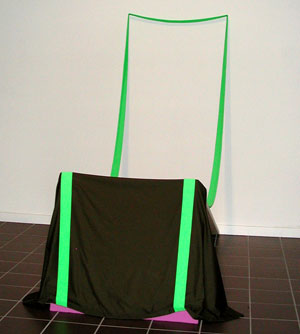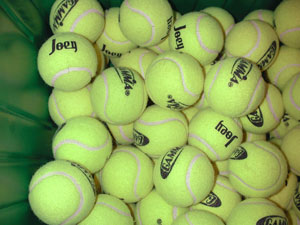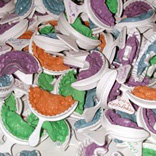He said/She Said is a feature where the two distinct opinions of a couple are being voiced in lieu of a conversation, allowing for an art review in the format of a disscussion.-ed.
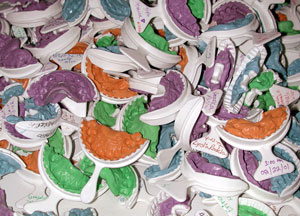
Margarita Cabrera...Piled Up Tension Along The Rio Grande...July-December 2001, 2001...polyvinyl Syloxanne on plastic trays...
C. Sean Horton, the curator of Twang: Contemporary Sculpture from Texas, organized the show with the simple objective of presenting “a survey of contemporary sculpture from Texas” with “little more unifying these artists than the place in which they were born and/or live.”(1) It’s a big task, considering the number of sculptors in Texas today. So we looked and looked, and we realized that — lack of curatorial thesis notwithstanding — there were definitely some themes uniting most of the works in this show.
I. How can you pick a Texan out of a line-up?
(The regional look to art)
She Said: In Texas, I am often shocked by the number of people who feel comfortable wearing hot pink. This same ease with color was apparent in the Twang sculptures, as well as in the installation itself. Banished were the pristine white walls of the museum; instead the walls were the hues of voguish graphic design, circa 2002: orange, brown, and cool blue. They read as a kind of limited palette of the Texas landscape. The colors made the show extra vivid, and set off sculptures that might have been dead in a more subdued space. Sharon Engelstein‘s bulbous white Rapid Protoyping objects would have been easily overlooked, but their orange backdrop injected them with a little more life than they’d have had otherwise.
In her work Sham, Katy Heinlein uses color to shake things up, creating a naughty peek-a-boo effect in an otherwise minimal piece. Sham involves a drab brown cloth draped over a wedge form. The cloth is lifted ever-so-slightly by two lime green straps, to reveal a flash of purple beneath. The interaction of forms and the color choices invite the viewer to imbue the objects with a personal narrative. My own interpretation involved a Catholic schoolgirl, revealing what lurks beneath…
Janet Tyson‘s piece Zen Garden plays on the Japanese art of rock collecting, known as suiseki, where the perfect rock is something that is both found and created. Tyson has constructed an indoor Zen garden of “rocks” created from thousands of Lego bricks. But instead of the sedate, contemplative grays and browns of a typical Zen garden, Tyson’s garden uses a bright confetti of colors. It’s an interesting work because the sense of contemplation has been created from the perspective of an obsessive-compulsive: I will build my own serenity.
He Said: There does tend to be a humble, quirky, colorful tendency in the works in this show. The works are generally friendlier than the art I grew up around. The friendliness in Twang is best seen in the interactivity between works and viewer, although the use of bright, fun colors also manifests this notion. Margarita Cabrera‘s work Piled up Tension Along the Rio Grande, July – December 2001 attempts to blur the lines that divide people from both sides of the Rio Grande by inviting participants to release border tensions by biting into teeth molds. The actual work consists of a pile of colorful dental molds labeled with participants names piled on a pedestal. The artist (who herself has family in both Texas and Mexico), has experienced the deep mistrust which exists on opposite sides of the border. Cabrera’s intermingled teeth molds connect these particular Texans and Mexicans in a single pile of objects resulting from a shared action.
II. So, are people friendlier in Texas?
(A tendency towards personal narrative)
In the past decade, there has been a growing trend towards the insertion of personal narrative into art. Increasingly, artists are giving us their own fables to digest and buy into before we can fully appreciate their work. In the wake of this movement, you find the growing presence of “helpful” wall text, which often explains everything you need to gather from a work. This show was no exception:
She Said: Our experience of the artwork is definitely mediated, if not obstructed, by all the text. Does that indicate a failure on the art’s part, that it didn’t communicate this information to us on its own? Or is it laziness on our part as viewers, that we felt reluctant to take the time to investigate?
He Said: Or is it just that nowadays that there is more information, such as personal histories, that is attached to artwork, so the explanatory text is necessary?
She Said: One work in Twang that was almost entirely dependent on its descriptive text was In and Out Box (first reiteration) or, an Even Happier End to Kafka’s Amerika by Justin Kidd. This work informed the viewer via a wandering text that postcards which were supplied by the artist were to be written on and inserted into a shabbily-fabricated mailbox constructed from pink foam and various tapes. Kidd would then take your letters to Prague to mail them back home, to make it seem like you had been in Prague. It was a fanciful idea, but I just couldn’t get past the crapola aesthetic. It was like trying to construct Frankenstein, but in this work Kidd’s Frankenstein was never really reborn.
He Said: I liked the piece. The odd-looking box’s function is explained on a sheet reminiscent of a high school book report. The intentionally childlike construction of the mailbox (composed of foam, duct tape, and cardboard) seems to further the idea of playacting, and pretending to be in a fantastical city. Also it’s another example of an interactive work in the show.
She Said: An artist who did manage to animate his sculpture with a sense of human presence was Michael Powers in Love/Joey. In the room, a Playmate-brand tennis ball machine faces a wall painted with an elaborate net constructed of various colored rhinestones. Tennis balls silk-screened with the name “Joey” are strewn around the room. Behind the Playmate is a single white wall with script along the bottom, reminiscent of a Hallmark card or a memorial tattoo, commemorating Powers’ relationship with Joey Massacchio. The Playmate plays a one-sided game of catch with a wall, communicating ideas of remembrance, loss and futility. Unfortunately, because of concerns about an unmanned machine spewing out tennis balls into the gallery, the sculpture was only turned on at request.
III. Obviously fabricated or Obviously Fabricated Nature
(The presence of awe-shucks charm)
He Said: The bench by Chris Sauter is an example…
She Said: How is that “nature”?
He Said: I have an “or” in there.
She Said: Turn on the TV at any time and you are guaranteed to find at least one do-it-yourself program playing. The likes of Bob Villa and Martha Stewart have shown us how to transform our ordinary surroundings into the extraordinary with a little bit of hard work, select power tools, and a touch of imagination. Texans are no exception. While most people will hire someone to remodel their bathroom or fix a fence, most Texans will just do it themselves.
In Twang there is a contingent of artists whom I would bet watch these DIY programs with relevant frequency. Chris Sauter‘s Museum Bench gave the appearance that it was made by someone who was watching Norm on the New Yankee Workshop, and who jumped up, inspired, only to realize he had no materials on hand. Undeterred, he started marking the wall to cut out pieces of a bench from the drywall, leaving behind a grid of holes which transforms the utilitarian wall into a Mondrian-esque grid. The bench itself then becomes a dilemma because of its odd craftsmanship — how utilitarian is it, really?
He Said: The leftover wall in Museum Bench looks like a plastic sheet that contained the pop-out pieces in a model kit, but the model is already built, and the leftover is quite beautiful. The design of the bench and pieces cut out of the wall were well thought-out, and organized beforehand seemingly to create maximum efficiency.
She Said: Katrina Moorehead‘s elegant transformation of Styrofoam packing components into tiny pools with carefully laid 1/4″ tiles and glittery grout almost seems like something Martha Stewart might tackle (or an idea that Stewart would steal).
Kyle Wadsworth also employs a DIY aesthetic in his work Hedge, composed of dwarf yupon hollies housed in planters equipped with all-terrain wheels that spell out the word “HEDGE”. In today’s world of corporate unrest, Hedge presents a humorous examination of the transitory nature of companies and their interior decoration. Now as a company (perhaps a hedge fund?) downsizes or crumbles, at least it can take its shrubs with it.
He Said: I think the shrubbery-on-wheels allows a transitory cowboy to maintain his/her inner suburbanite dream. Wadsworth’s hedges can be taken with you wherever you go, either to beautify your surroundings or to prove your superiority over nature.
She Said: The work CFP 69 by Derrick Saunders sums up the transitional nature of a modern landscape. The work is composed of multicolored layers of latex paint built up during six months on a 2″x 6″ wood base. The layers of greens, browns, pinks, and whites suggest the blur of a Texas landscape as seen through a car window. The piece rests on two wooden sawhorses, alluding to the construction that is a constant in the lives of most Texans.
He Said: Our subheading for this section states that not only are some of the artists in the show referencing nature as their subject matter, but their constructions, while referencing real objects, do not function as a trompe l’oeil. Seams are left exposed and slide projectors are left in the open. We are allowed behind the scenes, where we discover that mountains are actually made of cardboard, imbuing much of the work in the show with a certain degree of charm and humility. Teresa O”Connor‘s my lustful gaze creates the illusion of a Texas sunset that can be enjoyed by parking your ass in a lawn chair while eating a Blue Bell Popsicle. The image of the sunset is projected onto vinyl forms by a slide projector, which sits on the floor, though unfortunately the projector bulb was burnt out when we visited.
She Said: This was another work that suffered from technical difficulties. But even without the projected sunset, you could still get the gist of a summer evening in Texas where two folks sit and exchange thoughts while they cool down with popsicles (in lieu of beer) and contemplate the setting sun.
He Said: Bill Davenport‘s Two Paintings on a Rock is a quirky construction of faux boulder pieces and two almost-identical paintings of a building or monument. The rocks” construction reminds me of an oversized diorama with rectangular angles and obvious brushstrokes; they only truly appear to us as rocks once the title is read. Souvenir and/or amateur paintings like these tend to be of more officially sanctioned tourist attractions, while roadside sculptures are typically created to attract people to see something that is less-than-spectacular. The paintings and the rocks are related, but their meaning when coexisting in one sculpture is unclear.
Other artists” fabricated works reference objects that exist in the world, but not necessarily in nature. An example of this is Ludwig Schwarz‘s faux helpline advertisement. This printed banner does not appear to be a fake at first, apart from its unlikely placement (on the side of a museum). Soon one may notice the misspelling of the word “anxieity.” Did someone screw up, or is Schwarz being clever? We really meant to call the helpline, but never did. (It is actually the number of the Art Museum of Southeast Texas.)
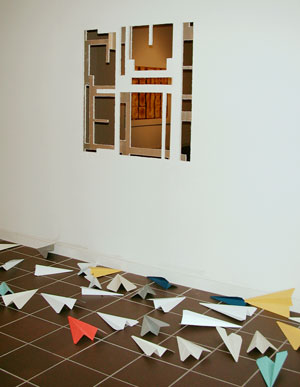
on floor:...Jessica Halonen...Flutter, 2004...enamel on aluminum.........wall cut-out:...Chris Sauter...Museum Bench (detail), 2004...bench constructed from musum drywall...
IV. Is the “twang” still audible?
He Said: I don’t know. They may say “y”all” here, but don’t people in other southern states say that too? Once we asked the museum staff to turn it on, Brad Tucker‘s piece seemed to embody my funky cowboy-infused idea of the Lone Star State. There is a twangy, slo-mo, surreal honky tonk soundtrack for this work, composed by the artist’s band. The sounds come from an imperfect, skipping record being played through a speaker in one side of a supposedly bone-shaped form covered with camouflage fabric. The materials employed are sensitively handled, resulting in a deliberate construction that exists as a chunk of an alternate universe, complete with soundtrack.
All in all, Twang is a very good survey. The show successfully exhibits the whole cowboy blaze-your-own-trails-and-screw-conformity ethos, which is very much present, at least in the works selected for this show. And it’s nice to note that the works in Twang stand up to anything being made elsewhere, too.
1. Horton, C. Sean. Exhibition Brochure: Twang: Contemporary Sculpture from Texas. Art Museum of South Texas, 2004
Images courtesy the artists and the Art Museum of Southeast Texas.
He Said/She Said are Joe and Jahje Ives. They are artists and writers living in Houston.


